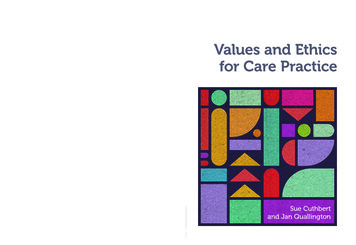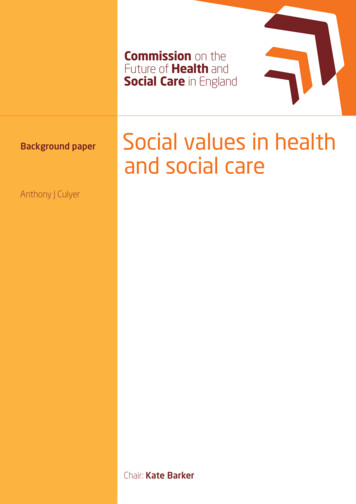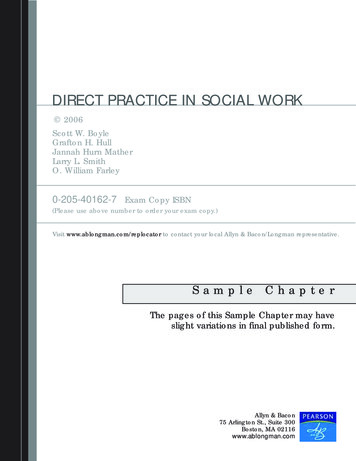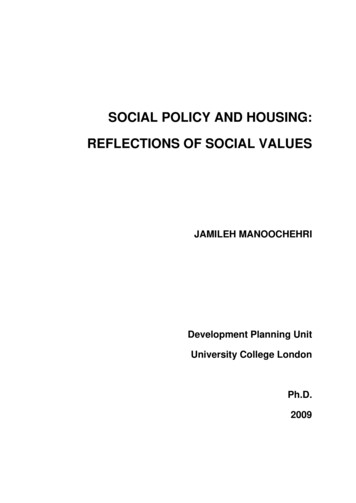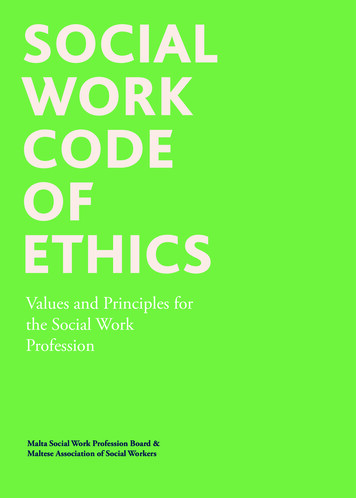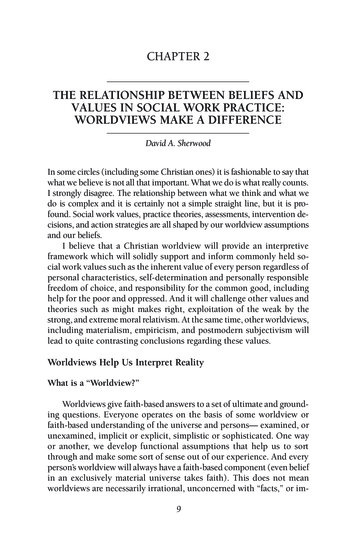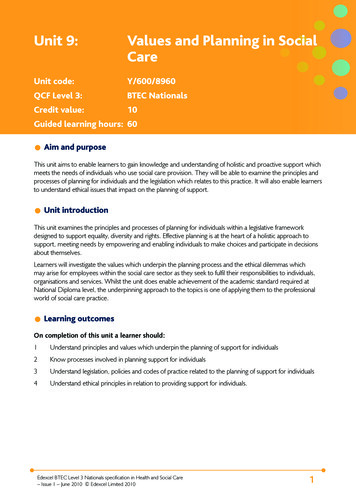
Transcription
ADULT SERVICESDeveloping social care:values and principlesBarbara Waine, Jane Tunstill and Pamela Meadows with Mark PeelDeveloping social care: the past, the present and the futurei
First published in Great Britain in July 2005by the Social Care Institute for Excellence SCIE 2005All rights reservedWritten by Barbara Waine, Jane Tunstill and Pamela Meadows with Mark PeelThe authors would like to thank Michael Turner, Lesley Jordan and Wendy Rose for theiradvice and support.Produced by The Policy PressFourth Floor, Beacon HouseQueen’s RoadBristol BS8 1QUtel 0117 331 4054fax 0117 331 is report is available in print and onlinewww.scie.org.ukSocial Care Institute for ExcellenceGoldings House2 Hay’s LaneLondon SE1 2HBtel 020 7089 6840fax 020 7089 6841textphone 020 7089 6893www.scie.org.uk
ADULT SERVICESCONTENTSChapter 11.1 Introduction1.2 Current brief1.3 The context of social care1.3.1 The stakeholders for social care1.3.2 Children1.3.3 Adults1.4 The workforce1.5 Values of social care112334567Chapter 22.1 Introduction2.2 defining the values2.2.1 Children2.2.2 Adults2.3 Values into practice2.3.1 Adults2.3.2 Children’s services2.3.2.1 Quality protects2.3.2.2 Every Child Matters2.4 Values and structures2.4.1 Regulation2.4.2 Performance management888891111121213141416Chapter 33.1 Who are the ‘consumers’? or beneficiaries ofSocial care?3.2 In what respect and contexts do those valuesand principles define them as resources, recipients,partners, co-producers and communities?3.3 In what contexts are the relationships to social caredefined as being based on social control?1919Chapter 44.1 Defining characteristics of social models4.2 Social models and professional definitions,workforce orientations and assumptionsabout ways of working4.3 The influence of the human rights frameworkon social models and the reflection of theframework in stakeholder definitions4.4 What is the influence of a human rightsframework on social models?4.5 How is the human rights framework reflectedin stakeholder definitions?252527Developing social care: values and principles1922283132iii
ivChapter 533Chapter 636Chapter 77.1 Conclusion7.2 Adults7.3 Children7.3.1 A family strengths approach7.3.2 An ecological and systems approach7.3.3 A value continuum which embraces notionsof prevention and protection7.4 Common issues for all service and service users7.4.1 Empowerment and workforce development7.4.2 Managerialism7.4.3 The challenges of partnership working7.4.4 Workforce issues39393940414242Bibliography464343434444
ADULT SERVICESChapter 11.1 IntroductionThis report reviews the evidence about the principles and values which underpin theprovision of social care in Britain. The definition of social care used is that providedby the Social Care Institute for Excellence (SCIE) – namely, ‘all interventions providedor funded by statutory and/or independent agencies which support older people,younger adults and children in their daily lives, and provide services which they areunable to provide for themselves, or which it is not possible for family members toprovide without additional support’. They can be provided at home, in day centres oron a residential basis, including substitute family care and care homes. Where thereare common themes between the different client groups for social care, we haveaimed to discuss these issues together. However, there are a number of ways in whichthe interests and values as well as the processes and policies relating to the differentclient groups vary. Where this is the case we have discussed them separately.As far as children are concerned, we concentrate on services for children who are ‘inneed’ as defined by the Children Act 1989, but we recognise that the Act espouses anapproach to children and families, based on the notion that ‘all children and familieshave needs’, whether that be for the provision of informal, formal or semi-formalsupport (Quinton 2004).1 We also recognise that foster care placements may be withfamily members, but formal placements supervised and supported by social services(currently) differ from private arrangements whereby family members help each otherout. At the other end of the spectrum, support from social services for children andyoung people intersects with interventions with the same young people by agencieswhich are part of the criminal justice system. We also recognise that some adults,particularly older people with higher incomes, are purchasing from their own resources,possibly with additional contributions from their families, services which are similar tothose provided by statutory agencies for other people. The boundaries between socialcare (supported and provided by the wider society) and private care purchased in themarket (paid for from private resources and provided by private or voluntary sectorproviders) are blurred. For these reasons the evidence cited sometimes crosses theboundary between the two, and indeed often applies equally to both types of care.The commission brief (see below) did not require a systematic review of all the literature,but pointed to a part of the relevant literature. This comprised the following: official documents from central government (for example, White Papers)publications of groups representing service userspublications of those regulatory bodies involved in the inspection of social servicesprovisionpublications from organisations concerned with the training and regulation of theworkforce.Relevant academic literature and research has also been used. Many significantcontributions, particularly in the area of disability and mental health, have been madeby academics who are also service users and who therefore have a dual perspective(for example, Jenny Morris, Michael Oliver and Peter Beresford).Developing social care: values and principles1
One further source of our material is the research reports resulting from successivegovernment-commissioned research initiatives. These are especially important inrespect of children and families (for example, Department of Health 2001a,2 Quinton2004). 3 The Department of Health, which has responsibility for adult services, andwas previously responsible for children’s services, has a history of commissioning peerreviewed research which is then incorporated into service planning and delivery. Thistradition has been considerably stronger in the context of services for children thanservices for adults. One of the features of this research activity is that some of it islocated in the same higher education institutions which deliver social work education,at both qualifying and post-qualifying levels. This constitutes an important route forthe transmission of both knowledge and values to new practitioners and to those whoengage in further training.1.2 Current briefOur brief from SCIE was to review: the underlying values and principles of social care and how they relate to thedeveloping agendas in local governance around community leadership, healthycommunities, sustainability and social inclusionthe essential characteristics of social models of care and support, together with thesignificance of the human rights framework for such modelswhat characteristics and contributions of social care need to be sustained within anynew organisational arrangements.Within this broad framework we were asked to focus on six key topics:1. How are the fundamental values and principles of social care defined by the majorstakeholders (that is, adults, children, families, carers, practitioners, managers,regulators and policy makers)?2. Who are the ‘consumers’ or beneficiaries of social care? In what respect and contextsdo those values and principles define them as resources, recipients, partners, coproducers, and communities? In what contexts are their relationships to social caredefined as being based on social contro
Developing social care: values and principles iii ADULT SERVICES Chapter 1 1 1.1 Introduction 1 1.2 Current brief 2 1.3 The context of social care 3 1.3.1 The stakeholders for social care 3 1.3.2 Children 4 1.3.3 Adults 5 1.4 The workforce 6 1.5 Values of social care 7 Chapter 2 8 2.1 Introduction 8 2.2 defining the values 8 2.2.1 Children 8
